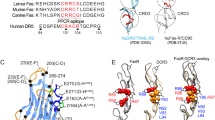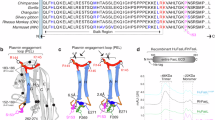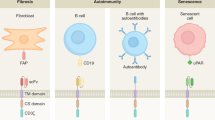ABSTRACT
Apoptosis is a complex process involving a large array of genes and mutation of any of these genes may lead to malignancy formation. Re-acquirement of FasL by tumor cells may enable them to evade the surveillance of immune system and thus contributes to the growth of tumor. Apart from traditional therapies, inducing apoptosis of tumor cell by new methods employing death receptor ligands and making use of Fas counterattack is also being developed.
Similar content being viewed by others
Log in or create a free account to read this content
Gain free access to this article, as well as selected content from this journal and more on nature.com
or
References
Byungsuk Kwon, Byung S Youn and Byoung S Kwon . Functions of newly identified members of the tumor necrosis factor receptor/ligand superfamilies in lymphocytes. Current Opinion in Immunology 1999; 11:340–5.
Boldin MP, Mett IL, Varfolomeev EE, Chumakov I, Shemer-Avni Y, Camonis JH, Wallach D . Self-association of the “death domain”of the p55 tumor necrosis factor (TNF) receptor and Fas/APO1 prompts signaling for TNF and Fas/APO1 effects. J Biol Chem 1995; 270(1):387–91.
Hsu H, Xiong J, Goeddel DV . The TNF receptor 1-associated protein TRADD signals cell death and NF-κB activation. Cell 1995; 81(4):495–504.
Enari M, Sakahira H, Yokoyama H, Okawa K, Iwamatsu A, Nagata S . A caspase-activated DNase that degrades DNA during apoptosis, and its inhibitor ICAD [see comments] [published erratum appears in Nature 1998 May 28; 393(6683):396 Nature 1998; 391(6662):43–50.
Xue D, Horvitz HR . Caenorhabditis elegans CED-9 protein is a bifunctional cell-death inhibitor. Nature 1997; 390(6657):305–8.
Orth K, Chinnaiyan AM, Garg M, Froelich CJ, Dixit VM . The CED-3/ICE-like protease Mch2 is activated during apoptosis and cleaves the death substrate lamin A. J Biol Chem 1996; 271(28):16443–6.
Kothakota S, Azuma T, Reinhard C, Klippel A, Tang J, Chu K, McGarry TJ, Kirschner MW, Koths K, Kwiatkowski DJ, Williams LT . Caspase-3-generated fragment of gelsolin: effector of morphological change in apoptosis. Science 1997; 278(5336):294–8.
Wen LP, Fahrni JA, Troie S, Guan JL, Orth K, Rosen GD . Cleavage of focal adhesion kinase by caspases during apoptosis. J Biol Chem 1997; 272:(41)26056–61.
Rudel T, Bokoch GM . Membrane and morphological changes in apoptotic cells regulated by caspase-mediated activation of PAK2. Science 1997; 276(5318):1571–4.
Cryns V, Yuan J . Proteases to die for [published erratum appears in Genes Dev 1999 Feb 1; 13(3):371] Genes Dev 1998; 12(11):1551–70.
Vogelstein B, Kinzler KW . p53 function and dysfunction. Cell 1992; 70(4):523–6.
Porwit-MacDonald A, Ivory K, Wilkinson S, Wheatley K, Wong L, Janossy G . Bcl-2 protein expression in normal human bone marrow precursors and in acute myelogenous leukemia. Leukemia 1995; 9(7):1191–8.
Campana D, Coustan-Smith E, Manabe A, Buschle M, Raimondi SC, Behm FG, Ashmun R, Arico M, Biondi A, Pui CH . Prolonged survival of B-lineage acute lymphoblastic leukemia cells is accompanied by overexpression of Bcl-2 protein. Blood 1993; 81(4):1025–31.
Shiraki K, Tsuji N, Shioda T, Isselbacher KJ, Takahashi H . Expression of Fas ligand in liver metastases of human colonic adenocarcinomas. Proc Natl Acad Sci USA 1997; 1994(12):6420–5.
Zeytun A, Hassuneh M, Nagarkatti M, Nagarkatti P . Fas-Fas ligand-based interactions between tumor cells and tumor-specific cytotoxic T lymphocytes: a lethal two-way street. Blood 1997; 90: 1952–1959.
Khar A, Varalakshmi C, Pardhasaradhi BVV, Mubarek Ali A, Kumari AL . Depletion of the natural killer cell population in the peritoneum by AK-5 tumor cells overexpressing Fas ligand: a mechanism of immune evasion. Cell Immunol 1998; 189:85–91.
O'Conell J, Bennett MW, O'Sullivan GC, Collin JK, Shanahan F . The Fas counterattack: cancer as a site of immune privilege. Immunol. Today 1999; 20:46–52.
Nicholas P. Restifo . Not so Fas: Re-evaluating the mechanisms of immune privilege and tumor escape. Nat Med 2000; 6(5)(5):493–5.
Hiroshi Arai, David Gordon, Elizabeth G Nabel, Gary J Nabel . Gene transfer of Fas ligand induces tumor regression in vivo, Proc. Natl Acad Sci USA 1997; 94:13862–7.
Fish DE . Apoptosis in cancer therapy: crossing the threshold. Cell 1994; 78:539–42.
Sakakura C, Koide K, Ichikawa D, et al. Analysis of histological therapeutic effect, apoptosis rate and p53 status after combined treatment with radiation, hyperthermia and 5-fluorouracil suppositories for advanced rectal cancers. Br J Cancer 1998; 77 (1):159–66.
Lotem J, Sachs L . Regulation by Bcl-2, c-Myc, and p53 of susceptibility to induction of apoptosis by heat shock and cancer chemotherapy compounds in differentiation-competent and defective myeloid leukemic cells. Cell Growth Differentiation 1993; 4(1):41–7.
Kitada S, Takayama S, DeRiel K, et al. Reversal of chemoresistance of lymphoma cells by antisense-mediated reduction of Bcl-2 gene expression. Antisense Res Dev 1994; 4(2):71–9.
Teixeira C, Reed JC, Pratt MAC . Estrogen promotes chemotherapeutic drug resistance expression on human breast cancer cells. Cancer Res 1995; 55(17):3902–7.
Lesoon-Wood LA, Kim WH, Kleinman HK, et al. Systemic gene therapy with p53 reduces growth and metastases of a malignant human breast cancer in nude mice. Human Gene Therapy 1995; 6(4):395–405.
Liu TJ, El-Naggar AK, McDonnell TJ, et al. Apoptosis induction mediated by wild type p53 adenoviral gene transfer in squamous cell carcinoma of the head and neck. Cancer Res 1995; 55(14):3117–22.
Fujiwara T, Cai DW, Georges RN, et al. Therapeutic effect of a retroviral wild-type p53 expression vector in an orthotopic lung cancer model. J Natl Cancer Inst 1994; 86(19):1458–62.
Cirielli C, Riccioni T, Yang C, et al. Adenovirus-mediated gene transfer of wild-type p53 results in melanoma cell apoptosis in vitro and in vivo. Int J Cancer 1995; 63(5):673–9.
Mizoguchi Y . Okada Y . Yoshida O . Fukumoto M . Bonavida B . Doxorubicin sensitizes human bladder carcinoma cells to Fas-mediated cytotoxicity. Cancer 1997; 79:1180–9.
Keane MM, Ettenberg SA, Nau MM, et al. Chemotherapy augments TRAIL-induced apoptosis in breast cell lines. Cancer Res 1999; 59(3):734–41.
Beltinger C, Fulda S, Kammertoens T, Meyer E, Uckert W, Debatin KM . Herpes simplex virus thymidine kinase/ganciclovir-induced apoptosis involves ligand-independent death receptor aggregation and activation of caspases. Proc Natl Acad Sci USA. 1999; 96(15):8699–704.
Robert M. Pitti, Scot A. Marsters, Siegfried Ruppert, Christopher J. Donahuel, et al. Induction of Apoptosis by Apo-2 Ligand, a New Member of the Tumor Necrosis Factor Cytokine Family. J Biol Chem 1996; 271(22):12687–90.
Ashkenazi A, Dixit VM . Death receptors: signaling and modulation. Science 1998; 281:1305–8.
Ashkenazi A, Pai RC, Fong S, Leung S, et al. Safety and antitumor activity of recombinant soluble Apo2 ligand. J Clin Invest 1999; 104(2):155–62.
Zhang XD, Franco A, Myers K, et al. Relation of TNF-related apoptosis-inducing ligand (TRAIL) receptor and FLICE-inhibitory protein expression to TRAIL-induced apoptosis of melanoma. Cancer Res 1999; 59(11):2747–53.
Griffith TS, Chin WA, Jackson GC, et al. Intracellular regulation of TRAIL-induced apoptosis in human melanoma cells. J Immunol 1998; 161(6):2833–40.
Thomas WD, Hersey P . TNF-related apoptosis-inducing ligand (TRAIL) induces apoptosis in Fas ligand- resistant melanoma cells and mediates CD4 T cell killing of target cells. J Immunol 1998; 161(5):2195–200.
Walczak H, Miller RE, Arial K, et al. Tumoricidal activity of tumor necrosis factor-related apoptosis-inducing ligand in vivo. Nat Med 1999; 5(2):157–63.
Frank S, Kohler U, Schackert G, et al. Expression of TRAIL and its receptors in human brain tumors. Biochem Biophys Res Commun 1999; 257(2):454–9.
Rieger J, Naumann U, Glaser T, et al. Apo2 ligand: a novel lethal weapon against malignant glioma? FEBS Lett 1998; 427(1):124–8.
Jo, M et al. TNF-related apoptosis inducing ligand (TRAIL)-induced apoptosis in normal human hepatocytes. Nat Med 2000; 6:564–7.
Theresa L. Witeside, Hannah Rabinowich . The role of Fas/FasL in immunosuppression induced by human tumors. Cancer mmunol Immunother 1998; 46:175–84.
Asok Mukhopadhyay, Jian Ni, Yifan Zhai, Guo-Liang Yu, Bharat B, Aggarwal . Identification and Characterization of a Novel Cytokine, THANK, a TNF Homologue That Activates Apoptosis, Nuclear Factor-κB, and c-Jun NH2-Terminal Kinase. J Biol Chem 1999; 274(23):15978–81.
Author information
Authors and Affiliations
Corresponding author
Rights and permissions
About this article
Cite this article
FAN, X., GUO, Y. Apoptosis in oncology. Cell Res 11, 1–7 (2001). https://doi.org/10.1038/sj.cr.7290060
Received:
Revised:
Accepted:
Issue date:
DOI: https://doi.org/10.1038/sj.cr.7290060
Keywords
This article is cited by
-
Energetic metabolic reprogramming in Jurkat DFF40-deficient cancer cells
Molecular and Cellular Biochemistry (2022)
-
Goat and buffalo milk fat globule membranes exhibit better effects at inducing apoptosis and reduction the viability of HT-29 cells
Scientific Reports (2019)
-
FasL −844T/C and Fas −1377G/A: mutations of pulmonary adenocarcinoma in South China and their clinical significances
Tumor Biology (2015)
-
FasL Gene -844T/C Mutation of Esophageal Cancer in South China and Its Clinical Significance
Scientific Reports (2014)
-
The diplotype Fas −1377A/−670G as a genetic marker to predict a lower risk of breast cancer in Chinese women
Tumor Biology (2014)



